Abstract
Pneumocystis carinii was obtained in high yield from the lungs of immunosuppressed rats by rupturing mammalian host cells, washing away the soluble mammalian dihydrofolate reductase, and harvesting intact organisms in association with the mammalian plasma membranes. P. carinii dihydrofolate reductase, measured in the 100,000 x g supernatant from sonicated organisms, was obtained in yields ranging up to 62 IU per rat. The enzyme prepared in the presence of protease inhibitors was stable when frozen in liquid nitrogen. P. carinii dihydrofolate reductase differed from the mammalian enzyme in that the former was slightly inhibited by 150 mM KCl, whereas the latter was stimulated over twofold by 150 mM KCl. The standard assay for P. carinii dihydrofolate reductase contained 0.12 mM NADPH and 92 microM dihydrofolic acid. Under these conditions, the 50% inhibitory concentrations of the known inhibitors trimethoprim, trimetrexate, and pyrimethamine were 12 microM, 42 nM, and 3.8 microM, respectively. These standard compounds were also tested against dihydrofolate reductase from rat liver to allow an assessment of the selectivity of the drugs. Although it was the least potent, trimethoprim was the most selective. Pyrimethamine was more potent but was nonselective. Trimetrexate was extremely potent but was selective for mammalian dihydrofolate reductase. A series of experimental compounds was obtained from the National Cancer Institute and other sources through the Developmental Therapeutics Branch of the Division of AIDS at the National Institute of Allergy and Infectious Diseases. Among the first 87 compounds tested, 11 had 50% inhibitory concentrations below that of trimetrexate and 3 were more selective than trimethoprim. The most promising compounds in this original group were chemically related to methotrexate.
Full text
PDF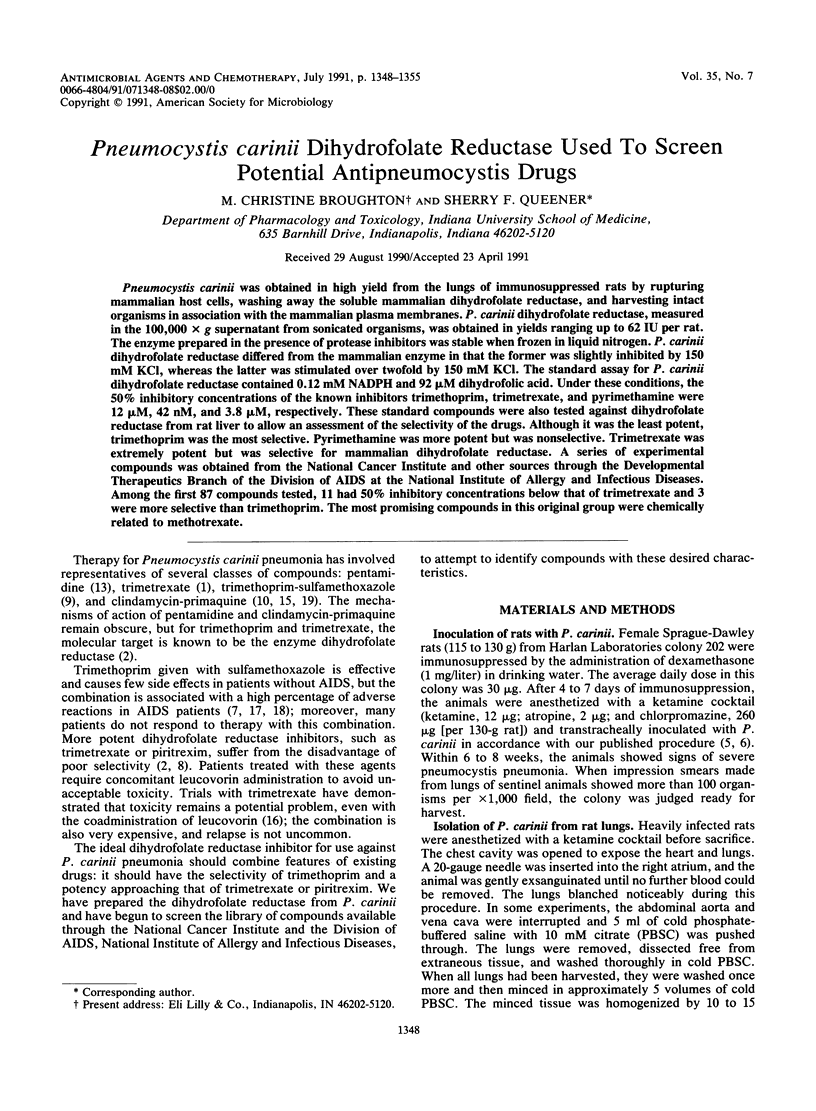
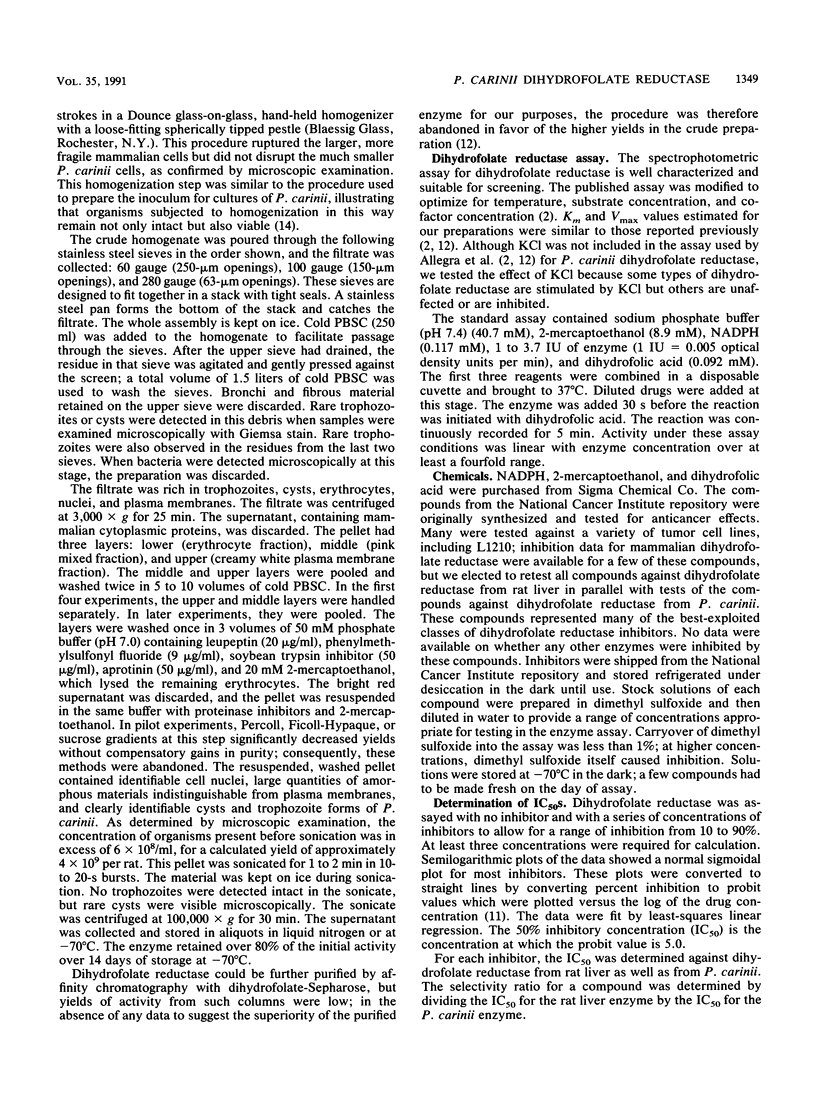
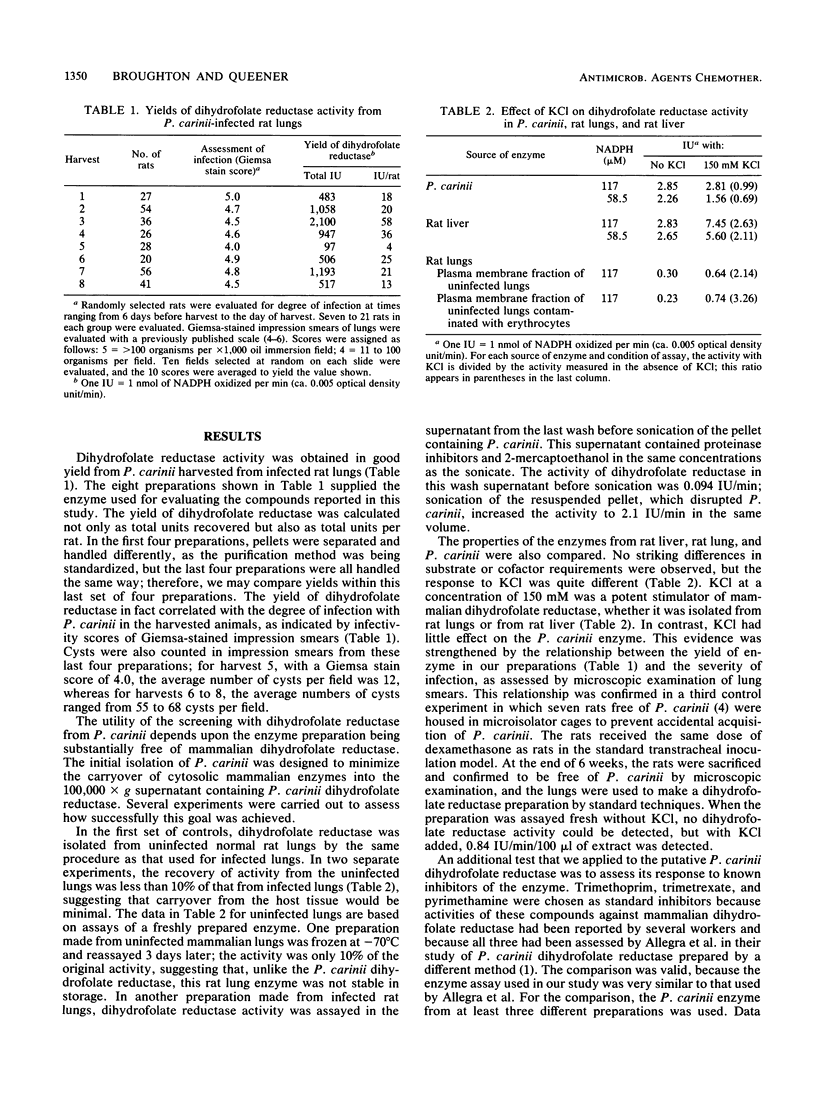
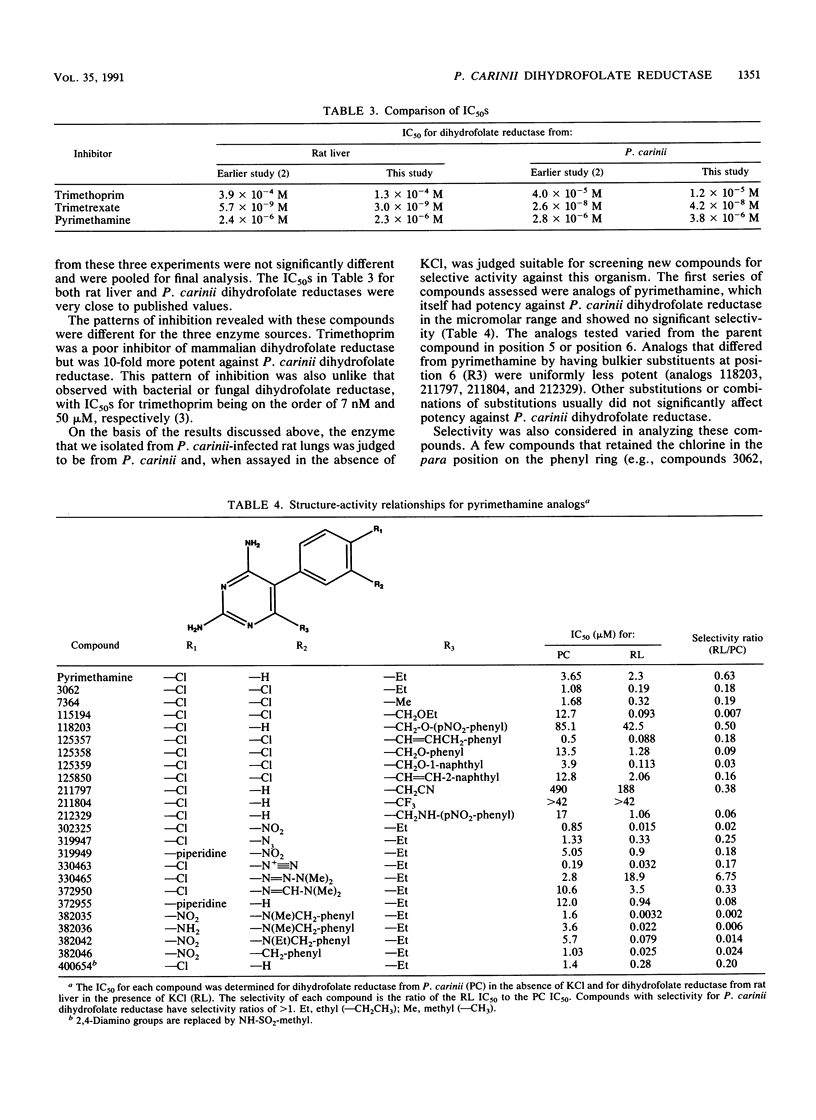
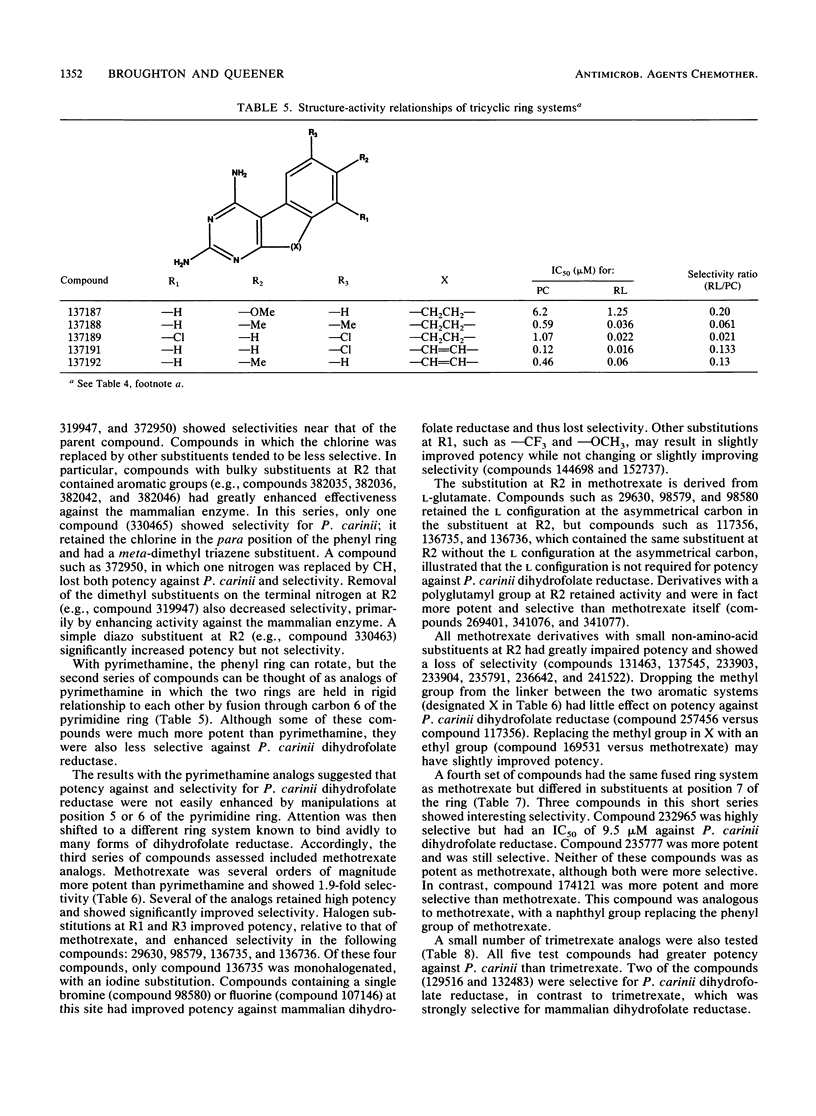
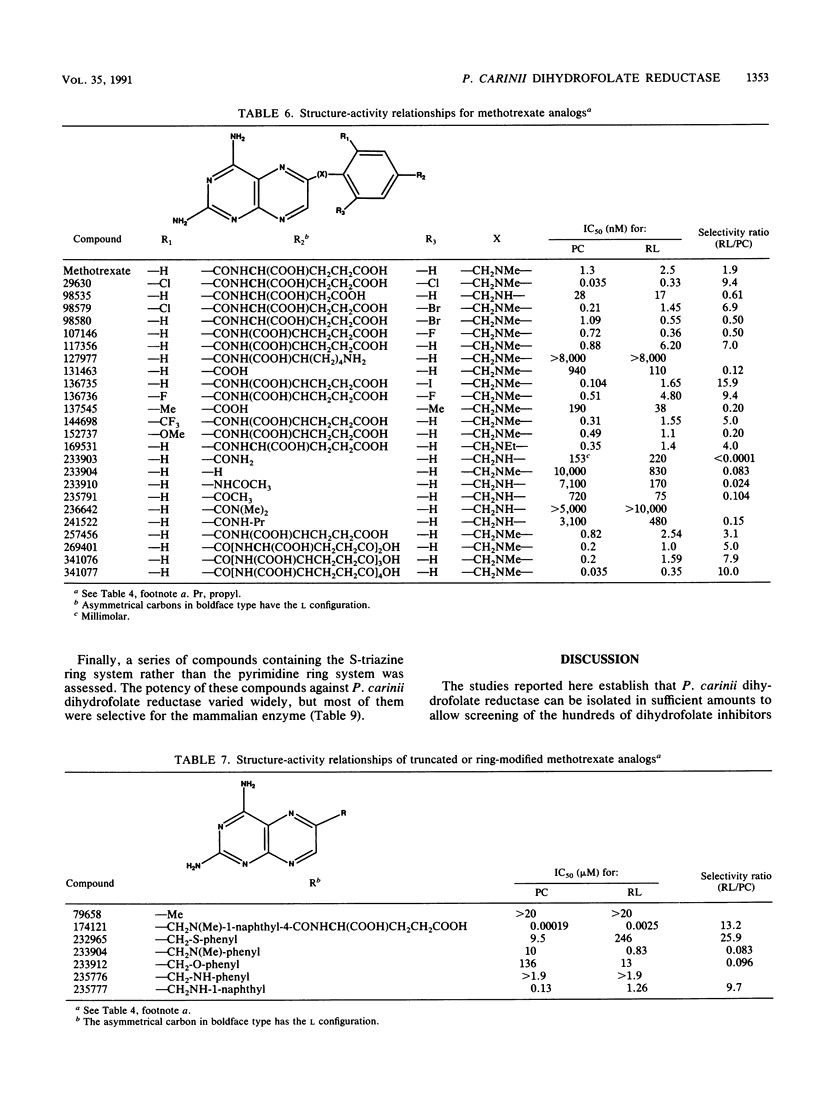
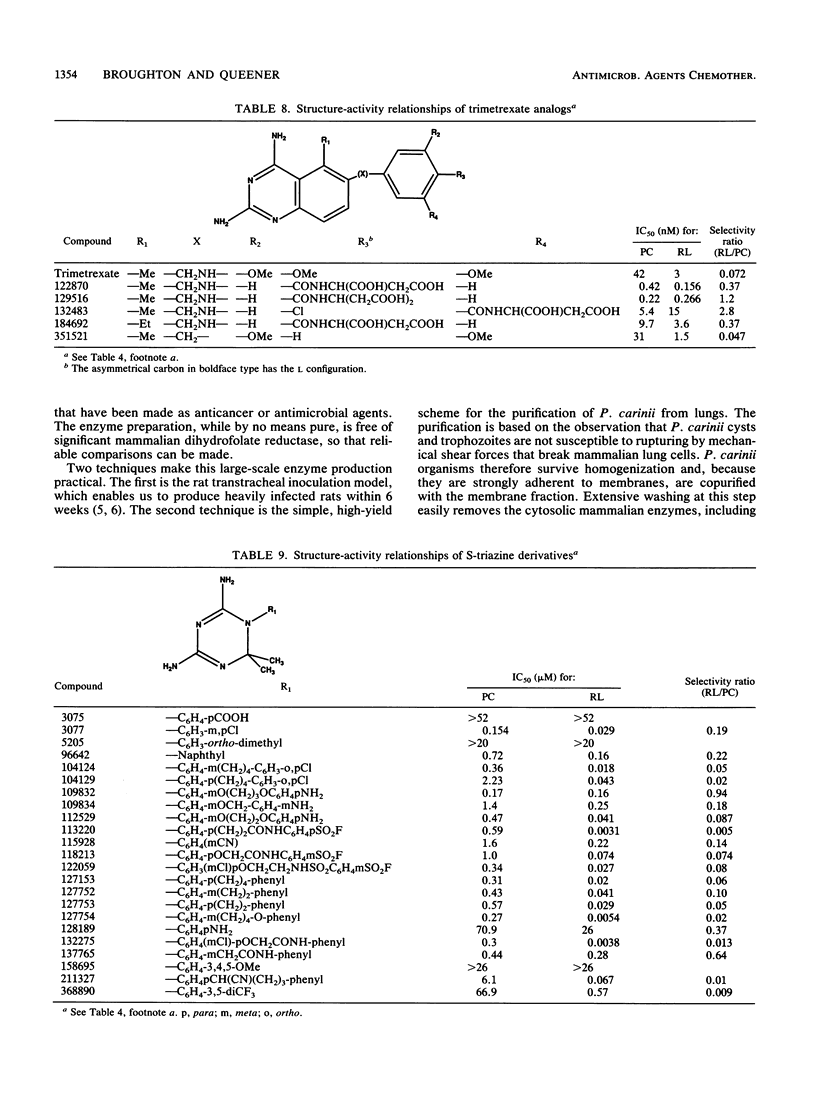
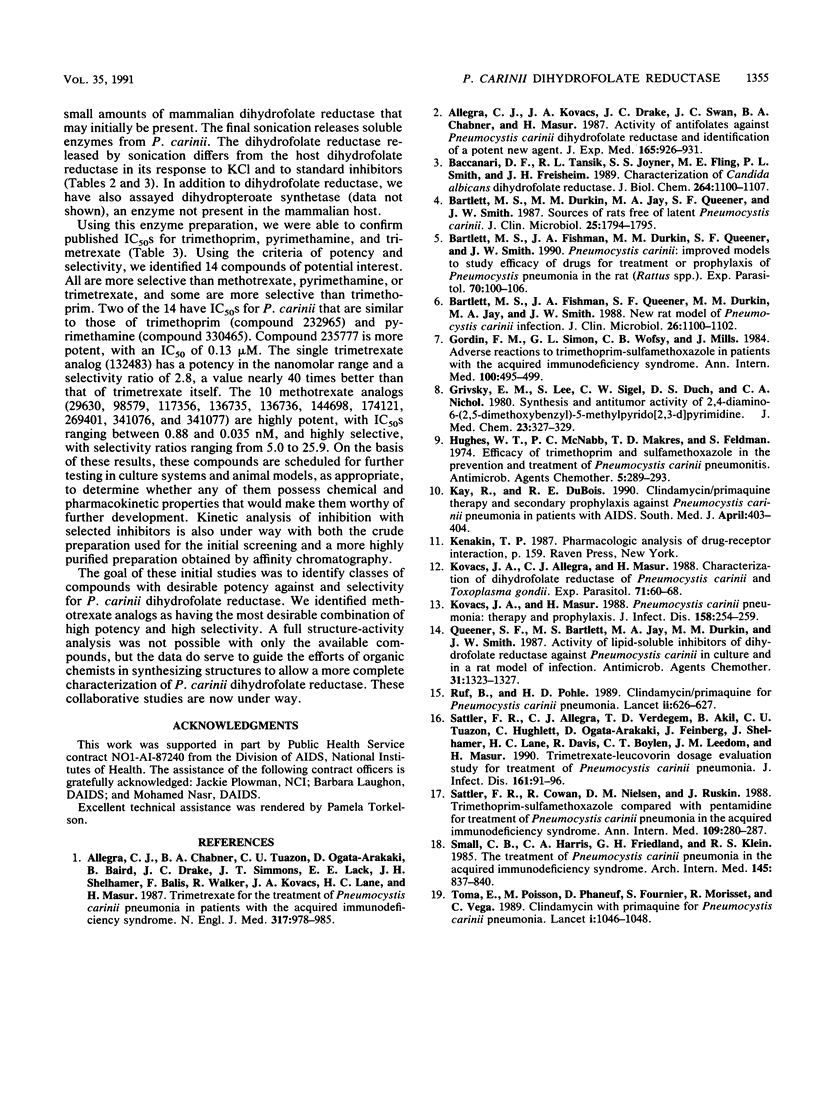
Selected References
These references are in PubMed. This may not be the complete list of references from this article.
- Allegra C. J., Chabner B. A., Tuazon C. U., Ogata-Arakaki D., Baird B., Drake J. C., Simmons J. T., Lack E. E., Shelhamer J. H., Balis F. Trimetrexate for the treatment of Pneumocystis carinii pneumonia in patients with the acquired immunodeficiency syndrome. N Engl J Med. 1987 Oct 15;317(16):978–985. doi: 10.1056/NEJM198710153171602. [DOI] [PubMed] [Google Scholar]
- Allegra C. J., Kovacs J. A., Drake J. C., Swan J. C., Chabner B. A., Masur H. Activity of antifolates against Pneumocystis carinii dihydrofolate reductase and identification of a potent new agent. J Exp Med. 1987 Mar 1;165(3):926–931. doi: 10.1084/jem.165.3.926. [DOI] [PMC free article] [PubMed] [Google Scholar]
- Baccanari D. P., Tansik R. L., Joyner S. S., Fling M. E., Smith P. L., Freisheim J. H. Characterization of Candida albicans dihydrofolate reductase. J Biol Chem. 1989 Jan 15;264(2):1100–1107. [PubMed] [Google Scholar]
- Bartlett M. S., Durkin M. M., Jay M. A., Queener S. F., Smith J. W. Sources of rats free of latent Pneumocystis carinii. J Clin Microbiol. 1987 Sep;25(9):1794–1795. doi: 10.1128/jcm.25.9.1794-1795.1987. [DOI] [PMC free article] [PubMed] [Google Scholar]
- Bartlett M. S., Fishman J. A., Durkin M. M., Queener S. F., Smith J. W. Pneumocystis carinii: improved models to study efficacy of drugs for treatment or prophylaxis of Pneumocystis pneumonia in the rat (Rattus spp.). Exp Parasitol. 1990 Jan;70(1):100–106. doi: 10.1016/0014-4894(90)90089-u. [DOI] [PubMed] [Google Scholar]
- Bartlett M. S., Fishman J. A., Queener S. F., Durkin M. M., Jay M. A., Smith J. W. New rat model of Pneumocystis carinii infection. J Clin Microbiol. 1988 Jun;26(6):1100–1102. doi: 10.1128/jcm.26.6.1100-1102.1988. [DOI] [PMC free article] [PubMed] [Google Scholar]
- Gordin F. M., Simon G. L., Wofsy C. B., Mills J. Adverse reactions to trimethoprim-sulfamethoxazole in patients with the acquired immunodeficiency syndrome. Ann Intern Med. 1984 Apr;100(4):495–499. doi: 10.7326/0003-4819-100-4-495. [DOI] [PubMed] [Google Scholar]
- Grivsky E. M., Lee S., Sigel C. W., Duch D. S., Nichol C. A. Synthesis and antitumor activity of 2,4-diamino-6-(2,5-dimethoxybenzyl)-5-methylpyrido[2,3-d]pyrimidine. J Med Chem. 1980 Mar;23(3):327–329. doi: 10.1021/jm00177a025. [DOI] [PubMed] [Google Scholar]
- Hughes W. T., McNabb P. C., Makres T. D., Feldman S. Efficacy of trimethoprim and sulfamethoxazole in the prevention and treatment of Pneumocystis carinii pneumonitis. Antimicrob Agents Chemother. 1974 Mar;5(3):289–293. doi: 10.1128/aac.5.3.289. [DOI] [PMC free article] [PubMed] [Google Scholar]
- Kay R., DuBois R. E. Clindamycin/primaquine therapy and secondary prophylaxis against Pneumocystis carinii pneumonia in patients with AIDS. South Med J. 1990 Apr;83(4):403–404. doi: 10.1097/00007611-199004000-00010. [DOI] [PubMed] [Google Scholar]
- Kovacs J. A., Allegra C. J., Masur H. Characterization of dihydrofolate reductase of Pneumocystis carinii and Toxoplasma gondii. Exp Parasitol. 1990 Jul;71(1):60–68. doi: 10.1016/0014-4894(90)90008-z. [DOI] [PubMed] [Google Scholar]
- Kovacs J. A., Masur H. Pneumocystis carinii pneumonia: therapy and prophylaxis. J Infect Dis. 1988 Jul;158(1):254–259. doi: 10.1093/infdis/158.1.254. [DOI] [PubMed] [Google Scholar]
- Queener S. F., Bartlett M. S., Jay M. A., Durkin M. M., Smith J. W. Activity of lipid-soluble inhibitors of dihydrofolate reductase against Pneumocystis carinii in culture and in a rat model of infection. Antimicrob Agents Chemother. 1987 Sep;31(9):1323–1327. doi: 10.1128/aac.31.9.1323. [DOI] [PMC free article] [PubMed] [Google Scholar]
- Ruf B., Pohle H. D. Clindamycin/primaquine for Pneumocystis carinii pneumonia. Lancet. 1989 Sep 9;2(8663):626–627. doi: 10.1016/s0140-6736(89)90755-1. [DOI] [PubMed] [Google Scholar]
- Sattler F. R., Allegra C. J., Verdegem T. D., Akil B., Tuazon C. U., Hughlett C., Ogata-Arakaki D., Feinberg J., Shelhamer J., Lane H. C. Trimetrexate-leucovorin dosage evaluation study for treatment of Pneumocystis carinii pneumonia. J Infect Dis. 1990 Jan;161(1):91–96. doi: 10.1093/infdis/161.1.91. [DOI] [PubMed] [Google Scholar]
- Sattler F. R., Cowan R., Nielsen D. M., Ruskin J. Trimethoprim-sulfamethoxazole compared with pentamidine for treatment of Pneumocystis carinii pneumonia in the acquired immunodeficiency syndrome. A prospective, noncrossover study. Ann Intern Med. 1988 Aug 15;109(4):280–287. doi: 10.7326/0003-4819-109-4-280. [DOI] [PubMed] [Google Scholar]
- Small C. B., Harris C. A., Friedland G. H., Klein R. S. The treatment of Pneumocystis carinii pneumonia in the acquired immunodeficiency syndrome. Arch Intern Med. 1985 May;145(5):837–840. [PubMed] [Google Scholar]
- Toma E., Fournier S., Poisson M., Morisset R., Phaneuf D., Vega C. Clindamycin with primaquine for Pneumocystis carinii pneumonia. Lancet. 1989 May 13;1(8646):1046–1048. doi: 10.1016/s0140-6736(89)92446-x. [DOI] [PubMed] [Google Scholar]


